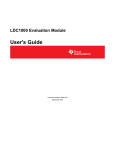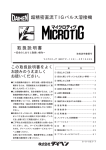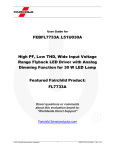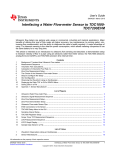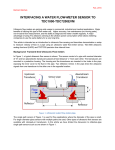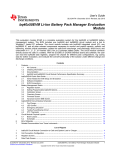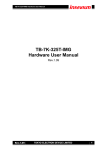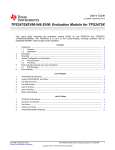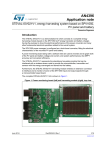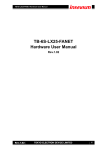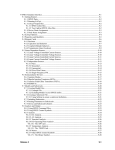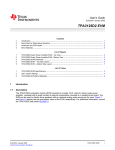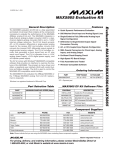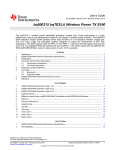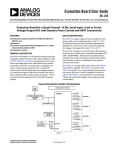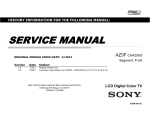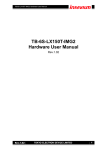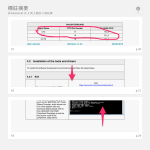Download TDC1000-TDC7200EVM User`s Guide (Rev. A)
Transcript
TDC1000-TDC7200EVM User’s Guide User's Guide Literature Number: SNIU021A October 2014 – Revised November 2015 Contents 1 General Description.............................................................................................................. 5 2 EVM Package Contents ......................................................................................................... 7 3 Quick Start .......................................................................................................................... 9 4 Software Installation ........................................................................................................... 11 4.1 5 TDC1000-TDC7200EVM Setup and Operation ......................................................................... 13 5.1 5.2 6 Graphical User Interface (GUI) ........................................................................................... 11 EVM Connections .......................................................................................................... 13 Launching the Software ................................................................................................... 14 Troubleshooting ................................................................................................................. 20 6.1 6.2 6.3 Jumpers ..................................................................................................................... 20 LEDs ......................................................................................................................... 21 Driver Errors ................................................................................................................ 21 7 Firmware Upgrade .............................................................................................................. 24 8 Board Layout ..................................................................................................................... 27 ......................................................................................................................... 35 10 Bill of Materials .................................................................................................................. 39 Revision History .......................................................................................................................... 44 9 Schematic 2 Contents SNIU021A – October 2014 – Revised November 2015 Submit Documentation Feedback Copyright © 2014–2015, Texas Instruments Incorporated www.ti.com List of Figures 3-1. TDC1000-TDC7200EVM Evaluation Board .............................................................................. 9 4-1. TDC1000-TDC7200EVM Installation Directory ......................................................................... 11 5-1. Transducer Connected to Channel 1 (TX1/RX2) 5-2. TDC1000_7200EVM Graph............................................................................................... 14 5-3. Plot of TOF of Water in Test Cell 5-4. 5-5. 5-6. 5-7. 6-1. 6-2. 6-3. 7-1. 7-2. 8-1. 8-2. 8-3. 8-4. 8-5. 8-6. 8-7. 8-8. 9-1. 9-2. 9-3. ...................................................................... ........................................................................................ EVM GUI - TDC1000 Tab ................................................................................................. EVM GUI – Debug Tab .................................................................................................... TDC1000-TDC7200EVM Board Connected to Oscilloscope ......................................................... START and STOP Signals on Oscilloscope ........................................................................... Jumpers ..................................................................................................................... TDC1000-TDC7200EVM LEDs........................................................................................... Device Manager with COM Port Name .................................................................................. Connection Error Pop-up Window ....................................................................................... USB Firmware Upgrade Window ......................................................................................... Top Overlay ................................................................................................................. Top Solder Mask ........................................................................................................... Top Layer.................................................................................................................... Mid Layer 1.................................................................................................................. Mid Layer 2.................................................................................................................. Bottom Layer ................................................................................................................ Bottom Solder Mask ....................................................................................................... Board Dimensions .......................................................................................................... TDC1000-TDC7200EVM Schematic 1 .................................................................................. TDC1000-TDC7200EVM Schematic 2 .................................................................................. TDC1000-TDC7200EVM Schematic 3 .................................................................................. SNIU021A – October 2014 – Revised November 2015 Submit Documentation Feedback Copyright © 2014–2015, Texas Instruments Incorporated List of Figures 13 15 16 16 17 18 20 21 22 24 25 27 28 29 30 31 32 32 33 35 36 37 3 www.ti.com List of Tables 4 ..................................................................................................................... 6-1. Jumpers 10-1. TDC1000-TDC7200EVM Bill of Materials ............................................................................... 39 List of Tables 20 SNIU021A – October 2014 – Revised November 2015 Submit Documentation Feedback Copyright © 2014–2015, Texas Instruments Incorporated Chapter 1 SNIU021A – October 2014 – Revised November 2015 General Description This guide details the use of the TDC1000-TDC7200EVM evaluation module (referred to as EVM for the remainder of this document). The TDC1000 analog-front-end (AFE) is an ultrasonic analog-front-end for Time-of-Flight (TOF) applications operating with ultrasound frequencies up to 4MHz.The TDC7200 is a Time to Digital Converter (TDC) that performs the function of a stopwatch and measures the elapsed time between up to five events. In addition to the EVM, a Steminc 15mm 1Mhz transducer is included in the evaluation kit. It has been provided for experimentation with liquid level applications and liquid identification/concentration applications. This transducer is not suitable for flow meter applications. For instructions how to mount the transducer on a tank, please refer to Application Note SNAA266 (http://www.ti.com/lit/pdf/snaa266). The EVM can be used for many time-of-flight applications such as gas, water, and heat flow meter, fluid level detection, concentration and fluid identification, and proximity or distance measurement. The EVM allows for two ultrasonic transducer connections, and two RTD connections for temperature measurements. It uses the on-board MSP430F5528 to process data and a user-friendly GUI interface to display the data. SNIU021A – October 2014 – Revised November 2015 Submit Documentation Feedback Copyright © 2014–2015, Texas Instruments Incorporated General Description 5 www.ti.com 6 General Description SNIU021A – October 2014 – Revised November 2015 Submit Documentation Feedback Copyright © 2014–2015, Texas Instruments Incorporated Chapter 2 SNIU021A – October 2014 – Revised November 2015 EVM Package Contents The TDC1000-TDC7200EVM evaluation kit comes with the following: • On-board TDC7200 and TDC1000 • On-board MPS430 microcontroller • Steminc 15mm 1Mhz transducer (SMD15T21R111WL) • USB Mini-B to USB-A plug cable The example in this document uses a "test cell" which is comprised of an acrylic container with an ultrasonic transducer mounted on the side of the container. The acrylic container can be purchased from Tap Plastics at http://www.tapplastics.com/product/plastics/plastic_containers/clear_plastic_boxes/222, and/or STEMINC's transducer (p/n: SMD10T2R11) (http://www.steminc.com/PZT/en/piezo-ceramic-disc10x2mm-r-215-khz-wire-leads-smd10t2r111wl) can be mounted on the side of the test cell. For instructions to assemble your own "Test cell" please refer to Application Note SNAA266 (http://www.ti.com/lit/pdf/snaa266). SNIU021A – October 2014 – Revised November 2015 Submit Documentation Feedback Copyright © 2014–2015, Texas Instruments Incorporated EVM Package Contents 7 www.ti.com 8 EVM Package Contents SNIU021A – October 2014 – Revised November 2015 Submit Documentation Feedback Copyright © 2014–2015, Texas Instruments Incorporated Chapter 3 SNIU021A – October 2014 – Revised November 2015 Quick Start 1. Download the TDC1000-TDC7200EVM software 2. Install the GUI. For detailed information, see Chapter 4. 3. Fill the test cell with water; ensure the water level is above the transducer. Description of this test cell can be found in Chapter 2. 4. Connect the transducer to TX1 (J5, pin 8) and GND (J5, pin 7). For more information, see Section 5.1. 5. Connect the EVM board with a mini USB cable (J2). 6. Launch the GUI. 7. On the GRAPH tab, press the START GRAPH button. 8. The time of flight should be read in the TDC AVG VALUE section, and should be around 39.7 us (this result is only applicable if using the test cell discussed in Chapter 2) . Figure 3-1. TDC1000-TDC7200EVM Evaluation Board SNIU021A – October 2014 – Revised November 2015 Submit Documentation Feedback Copyright © 2014–2015, Texas Instruments Incorporated Quick Start 9 www.ti.com 10 Quick Start SNIU021A – October 2014 – Revised November 2015 Submit Documentation Feedback Copyright © 2014–2015, Texas Instruments Incorporated Chapter 4 SNIU021A – October 2014 – Revised November 2015 Software Installation 4.1 Graphical User Interface (GUI) Installing the TDC1000-TDC7200EVM GUI software: 1. Download the TDC1000-TDC7200EVM_Installer-v??.zip into a known directory. This software can be found in http://www.ti.com/tool/tdc1000-tdc7200evm. 2. Make sure that the EVM has the latest firmware. For detail information, refer to Chapter 7. 3. Run the setup.exe file located in [Unzip location]\TDC1000_7200EVM_Installerv??.zip\TDC1000_7200EVM_Installer\Installer\Volume. 4. Follow the pop-up screen instructions by clicking the Next button to install the software. Figure 4-1. TDC1000-TDC7200EVM Installation Directory 5. When the installation is done, click Finish. SNIU021A – October 2014 – Revised November 2015 Submit Documentation Feedback Copyright © 2014–2015, Texas Instruments Incorporated Software Installation 11 Graphical User Interface (GUI) 12 Software Installation www.ti.com SNIU021A – October 2014 – Revised November 2015 Submit Documentation Feedback Copyright © 2014–2015, Texas Instruments Incorporated Chapter 5 SNIU021A – October 2014 – Revised November 2015 TDC1000-TDC7200EVM Setup and Operation 5.1 EVM Connections 1. Connect the USB cable (J2) from the EVM to the PC. 2. Obtain a test cell (see image below) with an attached transducer. Fill the test cell with water until it is above the transducer. Description of this test cell can be found in Chapter 2. 3. Attach the transducer wires to the terminals TX1/RX2 (J5, pin 8) and GND (J5, pin 7) on the EVM board (see Figure 5-1). Figure 5-1. Transducer Connected to Channel 1 (TX1/RX2) SNIU021A – October 2014 – Revised November 2015 Submit Documentation Feedback TDC1000-TDC7200EVM Setup and Operation Copyright © 2014–2015, Texas Instruments Incorporated 13 Launching the Software 5.2 www.ti.com Launching the Software 1. Run the TDC1000_TDC7200EVM GUI software by clicking on Start >> All Programs >> Texas Instruments >> TDC1000_7200. Figure 5-2. TDC1000_7200EVM Graph 2. The message at the bottom of Figure 5-2, "Read All No Errors", indicates that the GUI is up and running and all the registers and hardware connection are correct; otherwise, refer to Chapter 6 to troubleshoot. 3. Go to the GRAPH tab on the TDC1000-7200EVM GUI and click START GRAPH. The time of flight (TOF) displays in the TDC AVG VALUE window (see Figure 5-3). Note: the default settings work correctly for the test cell discussed in Chapter 2. 4. If the substance under test experiences any disturbance, either by impurities being added or by shaking the container, the graph represents this as a change on TOF. 14 TDC1000-TDC7200EVM Setup and Operation SNIU021A – October 2014 – Revised November 2015 Submit Documentation Feedback Copyright © 2014–2015, Texas Instruments Incorporated Launching the Software www.ti.com Figure 5-3. Plot of TOF of Water in Test Cell 5. Follow these steps to verify the TOF of the GUI on the oscilloscope: (a) In the GUI, click on the "TDC1000" tab, then click to enable "CONTINUOUS TRIGGER". Refer to Figure 5-4. The message "Start Continuous Trigger successful!!" should appear at the bottom of the GUI. (b) Connect the oscilloscope to the following connector: (i) START (J4) (ii) STOP (J3) (iii) COMP_IN (J7) (c) If the signal on the oscilloscope is flickering, ensure that the "ENABLE POWER CYCLE" is disabled on the DEBUG tab. Refer to Figure 5-5. SNIU021A – October 2014 – Revised November 2015 Submit Documentation Feedback TDC1000-TDC7200EVM Setup and Operation Copyright © 2014–2015, Texas Instruments Incorporated 15 Launching the Software www.ti.com Figure 5-4. EVM GUI - TDC1000 Tab Figure 5-5. EVM GUI – Debug Tab 16 TDC1000-TDC7200EVM Setup and Operation SNIU021A – October 2014 – Revised November 2015 Submit Documentation Feedback Copyright © 2014–2015, Texas Instruments Incorporated Launching the Software www.ti.com Figure 5-6. TDC1000-TDC7200EVM Board Connected to Oscilloscope SNIU021A – October 2014 – Revised November 2015 Submit Documentation Feedback TDC1000-TDC7200EVM Setup and Operation Copyright © 2014–2015, Texas Instruments Incorporated 17 Launching the Software www.ti.com Figure 5-7. START and STOP Signals on Oscilloscope 6. Observe the START (yellow), STOP (Green), and COMP_IN (purple) signals on the oscilloscope and measure the time difference between the rising edge of the START signal to the rising edge of the STOP signal. Verify the time difference matches the TDC AVG VALUE on the GUI. 7. Find the width of the test cell with the following equations: • • • 18 d: distance t: time of flight (TOF) v: speed of sound through the medium (water = 1484m/s at 20C.) For example, the TOF of the test cell filled with water is 39.755 us, so d = (39.755us*1484 m/s) / 2 = 29.5 mm. The test cell is therefore 29.5 mm wide. TDC1000-TDC7200EVM Setup and Operation SNIU021A – October 2014 – Revised November 2015 Submit Documentation Feedback Copyright © 2014–2015, Texas Instruments Incorporated Launching the Software www.ti.com SNIU021A – October 2014 – Revised November 2015 Submit Documentation Feedback TDC1000-TDC7200EVM Setup and Operation Copyright © 2014–2015, Texas Instruments Incorporated 19 Chapter 6 SNIU021A – October 2014 – Revised November 2015 Troubleshooting 6.1 Jumpers Table 6-1. Jumpers Jumpers Description JP1 Connects VDD_TDC7200 to V3p3 JP2 Connects AVCC1 to V3p3 JP3 Connects AVDD to VDD JP4 Connects V3p3 to VIO JP5 Trigger source selector: MPS430 trigger or TDC7200 trigger JP6 Oscillator source selector: i.e. CPU clock or external oscillator For default operation, place jumpers on the following: 1. JP1.P3 and JP1.P4 - OSC 2. JP2.P2 and JP2.P3 - TRIG-CPU 3. JP3.P1 and JP3.P2 - AVDD 4. JP4.P1 and JP4.P2 – VIO 5. JP5.P1 and JP5.P2 – TDC7200 trigger 6. JP6.P3 and JP6.P4 – on-board OSCILLATOR as the clock source Figure 6-1. Jumpers 20 Troubleshooting SNIU021A – October 2014 – Revised November 2015 Submit Documentation Feedback Copyright © 2014–2015, Texas Instruments Incorporated LEDs www.ti.com 6.2 LEDs Figure 6-2. TDC1000-TDC7200EVM LEDs 1. The Power LED (D4) and Link (D2) are ON if the board is powered. 2. If the D4 and D2 are OFF, check the physical connection to the PC. 3. The LINK LED is ON if there is an established communication with the PC. (a) If the LINK LED is blinking when the EVM is connected to the PC without the GUI running, then the crystal oscillator has a fault. (b) If the LINK LED is OFF, check the physical connection to the PC then verify if the correct firmware has been downloaded if the jumpers have been connected correctly. Note: The LINK LED blinks during graphing mode. 6.3 Driver Errors If there is a driver error when running the GUI, check the Device Manager for COM port name TDC1000_7200_EVM. SNIU021A – October 2014 – Revised November 2015 Submit Documentation Feedback Copyright © 2014–2015, Texas Instruments Incorporated Troubleshooting 21 Driver Errors www.ti.com Figure 6-3. Device Manager with COM Port Name If you do not see TDC1000_7200_EVM and instead see MSP430-USB Example, complete the following steps: 1. Open the Device Manager and find the MSP430-USB Example device. 2. Right-click and choose Update Driver Software. 3. Select Browse my Computer for driver installation. Navigate and select the folder containing the TDC1000_7200_EVM_DRIVER.inf file. 4. Close the setup window when the installation is complete. The Device Manager should now display TDC1000_7200_EVM followed by a COM port number. Take note of this number as it will be required to connect to the board from the GUI. 22 Troubleshooting SNIU021A – October 2014 – Revised November 2015 Submit Documentation Feedback Copyright © 2014–2015, Texas Instruments Incorporated Driver Errors www.ti.com SNIU021A – October 2014 – Revised November 2015 Submit Documentation Feedback Copyright © 2014–2015, Texas Instruments Incorporated Troubleshooting 23 Chapter 7 SNIU021A – October 2014 – Revised November 2015 Firmware Upgrade Note: This section is only necessary if the firmware needs to be changed. The TDC1000-TDC7200EVM comes preloaded with firmware already. To change the firmware, complete the following steps: 1. Connect the TDC1000-TDC7200EVM to a PC. 2. Open the TDC1000-7200EVM GUI then go to the DEBUG tab. Press OK if a connection error window pops up. Click on the Update Firmware button. Figure 7-1. Connection Error Pop-up Window 3. The MSP430 USB Firmware Upgrade windows pops up. Click Next to proceed on the first prompt; read and accept the license agreement and click Next to continue. 24 Firmware Upgrade SNIU021A – October 2014 – Revised November 2015 Submit Documentation Feedback Copyright © 2014–2015, Texas Instruments Incorporated www.ti.com Figure 7-2. USB Firmware Upgrade Window 4. Disconnect and reconnect the LaunchPad to PC while holding down the BSL button. 5. Select the Select Firmware button and browse to the firmware file. 6. Click on the Upgrade Firmware button to program the EVM. Close the application when done and restart the TDC1000_7200EVM GUI. SNIU021A – October 2014 – Revised November 2015 Submit Documentation Feedback Copyright © 2014–2015, Texas Instruments Incorporated Firmware Upgrade 25 www.ti.com 26 Firmware Upgrade SNIU021A – October 2014 – Revised November 2015 Submit Documentation Feedback Copyright © 2014–2015, Texas Instruments Incorporated Chapter 8 SNIU021A – October 2014 – Revised November 2015 Board Layout Figure 8-1. Top Overlay SNIU021A – October 2014 – Revised November 2015 Submit Documentation Feedback Copyright © 2014–2015, Texas Instruments Incorporated Board Layout 27 www.ti.com Figure 8-2. Top Solder Mask 28 Board Layout SNIU021A – October 2014 – Revised November 2015 Submit Documentation Feedback Copyright © 2014–2015, Texas Instruments Incorporated www.ti.com Figure 8-3. Top Layer SNIU021A – October 2014 – Revised November 2015 Submit Documentation Feedback Copyright © 2014–2015, Texas Instruments Incorporated Board Layout 29 www.ti.com Figure 8-4. Mid Layer 1 30 Board Layout SNIU021A – October 2014 – Revised November 2015 Submit Documentation Feedback Copyright © 2014–2015, Texas Instruments Incorporated www.ti.com Figure 8-5. Mid Layer 2 SNIU021A – October 2014 – Revised November 2015 Submit Documentation Feedback Copyright © 2014–2015, Texas Instruments Incorporated Board Layout 31 www.ti.com Figure 8-6. Bottom Layer Figure 8-7. Bottom Solder Mask 32 Board Layout SNIU021A – October 2014 – Revised November 2015 Submit Documentation Feedback Copyright © 2014–2015, Texas Instruments Incorporated www.ti.com Figure 8-8. Board Dimensions SNIU021A – October 2014 – Revised November 2015 Submit Documentation Feedback Copyright © 2014–2015, Texas Instruments Incorporated Board Layout 33 www.ti.com 34 Board Layout SNIU021A – October 2014 – Revised November 2015 Submit Documentation Feedback Copyright © 2014–2015, Texas Instruments Incorporated SNIU021A – October 2014 – Revised November 2015 Submit Documentation Feedback Copyright © 2014–2015, Texas Instruments Incorporated 2 4 6 8 10 J6 DNP 1 3 5 7 9 14 12 10 8 6 4 2 GPIO4 GPIO3 GPIO2 GPIO1 1 2 3 4 EP IO5 IO6 IO7 IO8 9 GND 142-0701-201 J8 GND JP3 1 2 V3p3 1 2 GND VIO R38 1.00k RTD2 RTD1 GND GND GND GND GND 1 GND OUT GND R50 51.1 0 R49 GND 2 JP6 5 3 1 R45 33 VCOM STOP START TP9 DNP OSC_SOURCE_SEL 6 4 2 R48 33 3 OSC_OUT ExtClock ASEMB-8.000MHZ-LY-T 8MHz STANDBY VDD Y2 300pF CPU_CLK_OUT 1 4 RX2 300pF C43 capacitances onto RX1&RX2 C42 RX1 0.01µF C28 SH-JP6 C41 0.1µF C38 0.1µF 60 ohm FB3 C40 0.01µF 60 ohm FB2 C37 0.01µF Place filter caps to VDD pins GND VDD_TDC1000 C46 10µF R36 10.0Meg R35 10.0Meg GND TX1 TX2 SPI_MISO SPI_MOSI C41& 42 must be close to TDC1000 RX SPI_SCLK pins. Place minimal parasitic TDC1000_SPI_CSB SH-JP4 VIO JP4 SH-JP3 VDD GND Place the ground TP close to VDD jumper JP TP11 AVDD R41 0 OSC_ENABLE R42 0 EXT_OSC 0.1µF 0.01µF GND C45 C44 60 ohm FB4 TDC1000_CHSEL GPIO7 GPIO6 GPIO5 V3p3 GND RTD1 RTD2 AVDD TX1/RX2 or RX2 TX1/RX2 or TX1 TX2/RX1or RX1 TX2/RX1or TX2 GPIO7 GPIO6 TDC1000_CHSEL USB_5V 5 6 7 8 TPD8E003DQDR IO1 IO2 IO3 IO4 U11 PPPC052LJBN-RC Pin 1 and pin 10 of the connector must be marked on the PC board GPIO5 GPIO4 GPIO3 GPIO2 GPIO1 GND 13 11 9 7 5 3 1 J5 Pin 1 and pin 14 of the connector must be marked on the PC board 200 200 R32 START R30 8 9 10 RTD1 RTD2 RREF VDD VDD 23 24 VIO 22 STOP 14 STOP 3 VCOM 13 START SDO SDI SCLK CSB 21 20 18 19 CLKIN CLK 25 28 TX1 27 TX2 RX1 1 RX2 CLK 2 COMPIN 7 COMPIN TP17 DNP TDC1000_ENABLE GND DNP DNP TP14 DNP TP13 GND C34 0.1µF TDC1000_RESET TDC1000_CHSEL TDC1000_ERRB GND C33 0.01µF V3p3 START C26 0.1µF V3p3 C25 0.01µF 2 1 6 2 1 6 GND NC NC Y1 Y0 GND NC NC Y1 Y0 8 3 VCOM GND 4 5 7 8 3 GND 4 5 7 COMPIN CDCLVC1102PW 1G CLKIN VDD U8 CDCLVC1102PW 1G CLKIN VDD U7 TDC7200_TRIGGER V3p3 V3p3 V3p3 V3p3 V5p0 10.0k J3 DNP 5 3 4 V5p0 V5p0 V+ V- GND J4 DNP GND V5p0 V+ V- GND 1 1 TP6 GND 142-0701-201 J7 GND 1 R46 50 TP10 GND C31 1µF CPU_CMP_OUT COMPIN_OUT 10pF C47 GND TP16 TP18 C30 0.1µF V5p0 GND C29 0.1µF VCOM_OUT TP15 R39 50 DNP BUFF_PGA TP8 Buffered STOP and START tra ces from the buffers to the connectors must be completely symmetrical to avoid introducing timing delay GND U9 LMH6601MG 1.00k R37 10pF C35 1 TP7 GND 1 TP5 U12 LMH6601MG 1.00k R44 10pF C39 5 3 4 142-0701-201 START_OUT 33 R33 TDC1000_MCU_START 10.0k R47 142-0701-201 STOP_OUT 33 R29 TDC1000_MCU_STOP R40 Component value = DNP means do not populate SH-JP5 JP5 TRIGGER_SOURCE_SEL MSP430_TRIGGER TRIGGER_IN R43 10.0k V3p3 TP12 Interstage Passive Filters: Configured for 1MHz C32 51pF C27 51pF U10 TDC1000PW C36 1000pF GND VCOM 1.00k R34 5.36k R31 5 PGAIN 4 LNAOUT 6 PGAOUT EN TRIGGER RESET CHSEL ERRB 15 16 17 11 12 GND 26 STOP 6 2 Buffered STOP and START tra ces from the buffers to the MCU must be completely symmetrical to avoid introducing timing delay 3 2 1 2 3 4 5 2 3 4 5 6 2 All the labels appearing on pin 2, 4, 6, 8, 10, 12 and 14 must be marked on the PC board 2 3 4 5 2 3 4 5 Directly connected STOP and START tra ces from TDC71000 to TDC7200 must be completely symmetrical and as short as possible to avoid introducing timing delay Chapter 9 SNIU021A – October 2014 – Revised November 2015 Schematic Figure 9-1. TDC1000-TDC7200EVM Schematic 1 Schematic 35 VBUS DM DP Copyright © 2014–2015, Texas Instruments Incorporated GND C19 0.1µF 6 1 2 GND IO3 IO4 TPD4E004DRYR VCC IO1 IO2 U5 GND V18 G G 3 4 5 1 3 GND C8 0.22µF GND 33 33 1 R24 1.5k GND R28 1.2M R22 R21 GND GND BSL SW1 PUR 33 2 GND 1 2 3 4 5 USB C20 220pF VUSB GND 1 2 J2 R26 33k GND C14 0.1µF GND GND C12 0.1µF 53 54 VBUS VUSB AVCC1 DVCC1 DVCC2 VBUS VUSB V18 VCORE PUR PU.0/DP PU.1/DM P5.0/A8/VREF+/VEREF+ P5.1/A9/VREF-/VEREFP5.2/XT2IN P5.3/XT2OUT P5.4/XIN P5.5/XOUT VBUS GND C22 22µF V5p0 GND D4 Green R19 1.0k GND P2.0/TA1.1 P2.1/TA1.2 P2.2/TA2CLK/SMCLK P2.3/TA2.0 P2.4/TA2.1 P2.5/TA2.2 P2.6/RTCCLK/DMAE0 P2.7/UCB0STE/UCA0CLK D5 1SMB5922BT3G 7.5V GND C23 1µF GND 1 4 3 65 49 14 56 16 39 64 59 60 61 62 63 1 2 3 4 5 6 7 8 41 42 43 44 45 46 47 48 26 27 28 29 30 31 32 33 GND GND VIN 3 GND ON/OFF IN GND CBYP OUT 4 5 2 GND 6.8pF C15 GND D3 D2 GND C9 2200pF R14 33k V3p3 261 R12 261 R9 C24 0.01µF GND LP2980IM5X-ADJ VOUT 5 JTAG_RST JTAG_TEST JTAG_TDO JTAG_TDI JTAG_TMS JTAG_TCK ADJ ON/OFF U3 CPU_CMP PEAK_DET GPIO5 GPIO3 GPIO4 GPIO1 GPIO2 33.0 EN_EX_VDD EX_VDD_FAULTB R51 U6 LP2985AIM5-3.3/NOPB 1 C18 10µF QFN PAD VSSU AVSS1 AVSS2 DVSS1 DVSS2 RST/NMI/SBWTDIO TEST/SBWTCK PJ.0/TDO PJ.1/TDI/TCLK PJ.2/TMS PJ.3/TCK P6.0/CB0/A0 P6.1/CB1/A1 P6.2/CB2/A2 P6.3/CB3/A3 P6.4/CB4/A4 P6.5/CB5/A5 P6.6/CB6/A6 P6.7/CB7/A7 P4.0/PM_UCB1STE/PM_UCA1CLK P4.1/PM_UCB1SIMO/PM_UCB1SDA P4.2/PM_UCB1SOMI/PM_UCB1SCL P4.3/PM_UCB1CLK/PM_UCA1STE P4.4/PM_UCA1TXD/PM_UCA1SIMO P4.5/PM_UCA1RXD/PM_UCA1SOMI P4.6/PM_NONE P4.7/PM_NONE 744043220 L1 Board Power P3.0/UCB0SIMO/UCB0SDA P3.1/UCB0SOMI/UCB0SCL P3.2/UCB0CLK/UCA0STE P3.3/UCA0TXD/UCA0SIMO P3.4/UCA0RXD/UCA0SOMI P1.0/TA0CLK/ACLK P1.1/TA0.0 P1.2/TA0.1 P1.3/TA0.2 P1.4/TA0.3 P1.5/TA0.4 P1.6/TA1CLK/CBOUT P1.7/TA1.0 U2 MSP430F5528IRGC C13 0.1µF 11 15 40 55 17 51 50 52 V18 VCORE PUR DP DM 9 10 57 58 12 13 34 35 36 37 38 18 19 20 21 22 23 24 25 Component value = DNP means do not populate GND 0 V3p3 SH-JP2 JP2 R13 R11 DNP CPU_SCLK CPU_MOSI OSC_ENABLE GPIO6 33 CPU_CLK C6 30pF R7 R6 C11 0.22µF VUSB 30pF C10 0.47µF VCORE C7 ABMM-24.000MHZ-B2-T 24.000MHz 2 4 Y1 SPI_MOSI SPI_MISO SPI_SCLK USB Physical Interface GND Place holes on the SPI lines for probing TDC1000_MCU_STOP TDC1000_MCU_START MSP430_TRIGGER AFE SPI uses MCU GPIO7 USCI_B0 SPI MSP_TDC_INT 9 8 Schematic 6 7 36 2 STOP is connected to TA0.0, as this has quickest responding ISR. In this way STOP pulses can be closer together. START is conne cted to TA0.1, which is slower. This produces a delay to timestamp, but this can be compensated. TRIGGER is on TA0.2, used to reset counter so there are no rollover issues. C21 2.2µF V3p3 C16 2.2µF GND R17 51.1k GND MEAS GND R18 102k Radj Orange Green LINK TP4 V3p3 AVDD MSP_TDC7200_EN TDC1000_ENABLE TDC1000_CHSEL TDC1000_RESET TDC1000_ERRB CPU_CLK_OUT TDC7200_SPI_CSB TDC1000_SPI_CSB 0 GND R23 100k V5p0 0 R16 3 4 1 JTAG_TEST R15 GND R5 DNP DNP DNP 13 11 9 7 5 3 1 GND ILIM OUT TPS2553DBV-1 EN FAULT IN U4 TSW-107-07-G-D 14 12 10 8 6 4 2 6 2 5 GND 0 R27 GND GND R20 240k JTAG_TCK JTAG_TMS JTAG_TDI JTAG_TDO CPU_CMP_OUT USB_5V Choose proper resistor values to comply with the MSP430 ADC input requirements R8 DNP EN_EX_VDD R25 1.0Meg EX_VDD_FAULTB V3p3 C17 1µF GND R10 DNP JTAG_RST GND Place Cap as close as possible DNPC5 to the MCU pin DNPC4 D1 1N4148W-7-F JTAG Programming Interface J1 CPU_CMP PEAK_DET www.ti.com Figure 9-2. TDC1000-TDC7200EVM Schematic 2 SNIU021A – October 2014 – Revised November 2015 Submit Documentation Feedback MSP_TDC_INT R2 10.0k V3p3 33 R1 1 8 11 9 10 12 SNIU021A – October 2014 – Revised November 2015 Submit Documentation Feedback Copyright © 2014–2015, Texas Instruments Incorporated TDC7200PW ENABLE INT CS DOUT DIN SCLK FLAG U1 GND C1 0.01µF GND TRIGG START STOP CLOCK VREG VDD GND GND 7 2 3 4 5 13 14 C2 0.1µF VDD_TDC7200 33 R3 60 ohm FB1 SH-JP1 TDC7200_TRIGGER START STOP V3p3 Component value = DNP means do not populate DNP TP3 DNP TP20 DNP TP21 TDC7200_SPI_CSB MSP_TDC7200_EN DNP TP2 SPI_MISO SPI_MOSI SPI_SCLK DNP TP19 6 Place caps close to the pin GND TP1 JP1 2 1 Place the TP close to the TDC7200 Power JP R4 DNP CLK CPU_CLK GND C3 1µF Place cap close to the pin www.ti.com Figure 9-3. TDC1000-TDC7200EVM Schematic 3 Schematic 37 www.ti.com 38 Schematic SNIU021A – October 2014 – Revised November 2015 Submit Documentation Feedback Copyright © 2014–2015, Texas Instruments Incorporated Chapter 10 SNIU021A – October 2014 – Revised November 2015 Bill of Materials Table 10-1. TDC1000-TDC7200EVM Bill of Materials Designator Description !PCB1 Printed Circuit Board C1, C24, C44 CAP, CERM, 0.01 uF, 25 V, +/-10%, X7R, 0603 C2, C26, C29, C30, C34, C38, C41, C45 Value Manufacturer Part Number Any SV601098 0.01 uF MuRata GRM188R71E103KA01 D CAP, CERM, 0.1 uF, 10 V, +/-10%, X5R, 0402 0.1 uF TDK C1005X5R1A104K C3, C23, C31 CAP, CERM, 1 uF, 25 V, +/-10%, X7R, 0603 1 uF MuRata GRM188R71E105KA12 D C6, C7 CAP, CERM, 30 pF, 100 V, +/-5%, C0G/NP0, 0603 30 pF MuRata GRM1885C2A300JA01 D C8, C11 CAP, CERM, 0.22 uF, 25 V, +/-10%, X5R, 0603 0.22 uF AVX 06033D224KAT2A C9 CAP, CERM, 2200 pF, 50 V, +/-10%, X7R, 0603 2200 pF Kemet C0603X222K5RACTU C10 CAP, CERM, 0.47 uF, 16 V, +/-10%, X7R, 0603 0.47 uF MuRata GRM188R71C474KA88 D C12, C13, C14, C19 CAP, CERM, 0.1 uF, 100 V, +/-10%, X7R, 0603 0.1 uF MuRata GRM188R72A104KA35 D C15 CAP, CERM, 6.8 pF, 50 V, +/-4%, C0G/NP0, 0603 6.8 pF AVX 06035A6R8CAT2A C16, C21 CAP, CERM, 2.2 uF, 16 V, +/-10%, X7R, 0805 2.2 uF Kemet C0805C225K4RACTU C17 CAP, CERM, 1 uF, 16 V, +/-10%, X5R, 0805 1 uF AVX 0805YD105KAT2A C18, C46 CAP, CERM, 10 uF, 10 V, +/-10%, X5R, 0805 10 uF Kemet C0805C106K8PACTU C20 CAP, CERM, 220 pF, 50 V, +/-1%, C0G/NP0, 0603 220 pF AVX 06035A221FAT2A C22 CAP, CERM, 22 uF, 16 V, +/-20%, X5R, 1206 22 uF AVX 1206YD226MAT2A C25, C33, C37, C40 CAP, CERM, 0.01 uF, 10 V, +/-10%, X5R, 0402 0.01 uF MuRata GRM155R61A103KA01 D C27, C32 CAP, CERM, 51 pF, 100 V, +/-5%, C0G/NP0, 0603 51 pF MuRata GRM1885C2A510JA01 D C28 CAP, CERM, 0.01 uF, 25 V, +/-5%, C0G/NP0, 0603 0.01 uF TDK C1608C0G1E103J SNIU021A – October 2014 – Revised November 2015 Submit Documentation Feedback Copyright © 2014–2015, Texas Instruments Incorporated Bill of Materials 39 www.ti.com Table 10-1. TDC1000-TDC7200EVM Bill of Materials (continued) 40 Designator Description Value Manufacturer Part Number C35, C39, C47 CAP, CERM, 10 pF, 50 V, +/-5%, C0G/NP0, 0603 10 pF AVX 06035A100JAT2A C36 CAP, CERM, 1000 pF, 50 V, +/- 5%, C0G/NP0, 0603 1000 pF TDK C1608C0G1H102J C42, C43 CAP, CERM, 300 pF, 50 V, +/-5%, C0G/NP0, 0603 300 pF MuRata GRM1885C1H301JA01 D D2, D4 LED, Green, SMD Green Lite-On LTST-C190GKT D3 LED, Orange, SMD Orange Lite-On LTST-C190KFKT D5 Diode, Zener, 7.5 V, 550 mW, SMB 7.5 V ON Semiconductor 1SMB5922BT3G FB1, FB2, FB3, FB4 0.8A Ferrite Bead, 60 ohm @ 100MHz, SMD 60 ohm Taiyo Yuden BK1608HS600-T H1, H2, H3, H4 Bumpon, Cylindrical, 0.312 X 0.200, Black 3M SJ61A1 J2 MINI USB 2.0 SMT TYPE AB 5 CONTACTS R/A, SMD Wurth Elektronik eiSos 651-305-142-821 J5 Receptacle, 7x2, 2.54 mm, R/A, TH Samtec SSW-107-02-G-D-RA J8 Connector, TH, SMA Emerson Network Power 142-0701-201 JP1, JP2, JP3, JP4 Header, TH, 100mil, 2x1, Gold plated, 230 mil above insulator Samtec TSW-102-07-G-S JP5 Header, TH, 100mil, 3x1, Gold plated, 230 mil above insulator Samtec TSW-103-07-G-S JP6 Header, TH, 100mil, 3x2, Gold plated, 230 mil above insulator Samtec TSW-103-07-G-D L1 Inductor, Shielded Drum Core, Ferrite, 22 uH, 0.7 A, 0.155 ohm, SMD Wurth Elektronik eiSos 744043220 LBL1 Thermal Transfer Printable Labels, 0.650" W x 0.200" H - 10,000 per roll Brady THT-14-423-10 R1, R3, R6, R7, R21, R22, R29, R33, R45, R48 RES, 33 ohm, 5%, 0.063W, 0402 33 Vishay-Dale CRCW040233R0JNED R2, R40, R43, R47 RES, 10.0k ohm, 1%, 0.1W, 0603 10.0k Yageo America RC0603FR-0710KL R9, R12 RES, 261 ohm, 1%, 0.1W, 0603 261 Vishay-Dale CRCW0603261RFKEA R13, R15, R16, R27, R41, R42, R49 RES, 0 ohm, 5%, 0.1W, 0603 0 Vishay-Dale CRCW06030000Z0EA R14, R26 RES, 33k ohm, 5%, 0.1W, 0603 33k Vishay-Dale CRCW060333K0JNEA R17 RES, 51.1k ohm, 1%, 0.1W, 0603 51.1k Vishay-Dale CRCW060351K1FKEA R18 RES, 102k ohm, 1%, 0.1W, 0603 102k Vishay-Dale CRCW0603102KFKEA R19 RES, 1.0k ohm, 5%, 0.1W, 0603 1.0k Vishay-Dale CRCW06031K00JNEA Bill of Materials 22 uH SNIU021A – October 2014 – Revised November 2015 Submit Documentation Feedback Copyright © 2014–2015, Texas Instruments Incorporated www.ti.com Table 10-1. TDC1000-TDC7200EVM Bill of Materials (continued) Designator Description Value Manufacturer Part Number R20 RES, 240k ohm, 5%, 0.1W, 0603 240k Vishay-Dale CRCW0603240KJNEA R23 RES, 100k ohm, 5%, 0.1W, 0603 100k Vishay-Dale CRCW0603100KJNEA R24 RES, 1.5k ohm, 5%, 0.063W, 0402 1.5k Vishay-Dale CRCW04021K50JNED R25 RES, 1.0Meg ohm, 5%, 0.1W, 0603 1.0 Meg Vishay-Dale CRCW06031M00JNEA R28 RES, 1.2Meg ohm, 5%, 0.1W, 0603 1.2 M Vishay-Dale CRCW06031M20JNEA R30, R32 RES, 200 ohm, 0.1%, 0.1W, 0603 200 Susumu Co Ltd RG1608P-201-B-T5 R31 RES, 5.36k ohm, 1%, 0.1W, 0603 5.36k Vishay-Dale CRCW06035K36FKEA R34, R37, R38, R44 RES, 1.00k ohm, 1%, 0.1W, 0603 1.00k Vishay-Dale CRCW06031K00FKEA R35, R36 RES, 10.0Meg ohm, 1%, 0.1W, 0603 10.0 Meg Vishay-Dale CRCW060310M0FKEA R39, R46 RES, 0 ohm, 5%, 0.1W, 0603 50 Vishay-Dale CRCW06030000Z0EA R50 RES, 51.1 ohm, 1%, 0.1W, 0603 51.1 Vishay-Dale CRCW060351R1FKEA R51 RES, 33.0 ohm, 1%, 0.1W, 0603 33.0 Vishay-Dale CRCW060333R0FKEA SH-JP1, SH-JP2, SHJP3, SH-JP4, SH-JP5, SH-JP6 Shunt, 100mil, Gold plated, Black 1x2 3M 969102-0000-DA SW1 Switch, Tactile, SPSTNO, 0.05A, 12 V, TH C&K Components PTS635SL50LFS TP1, TP6, TP8, TP11, TP16, TP18 Test Point, TH, Compact, Black Black Keystone 5006 TP5, TP7, TP10, TP15 Test Point, Miniature, Red, TH Red Keystone 5000 U1 STOPWATCH IC FOR TIME MEASUREMENT BETWEEN TWO EVENTS, PW0014A Texas Instruments TDC7200PW U2 Mixed Signal MicroController, RGC0064B Texas Instruments MSP430F5528IRGC U3 Micropower 50 mA Ultra Low-Dropout Adjustable Voltage Regulator, 5-pin SOT-23 Texas Instruments LP2980IM5X-ADJ U4 PRECISION ADJUSTABLE CURRENT-LIMITED POWERDISTRIBUTION SWITCHES, DBV0006A Texas Instruments TPS2553DBV-1 U5 ESD-Protection Array for High-Speed Data Interfaces, 4 Channels, 40 to +85 degC, 6-pin SON (DRY), Green (RoHS & no Sb/Br) Texas Instruments TPD4E004DRYR SNIU021A – October 2014 – Revised November 2015 Submit Documentation Feedback Copyright © 2014–2015, Texas Instruments Incorporated Bill of Materials 41 www.ti.com Table 10-1. TDC1000-TDC7200EVM Bill of Materials (continued) 42 Designator Description Manufacturer Part Number U6 Micropower 150 mA Low-Noise Ultra LowDropout Regulator, 5-pin SOT-23, Pb-Free Texas Instruments LP2985AIM5-3.3/NOPB U7, U8 3.3 V and 2.5 V LVCMOS HighPerformance Clock Buffer Family, PW0008A Texas Instruments CDCLVC1102PW U9, U12 2.4V R-R Out CMOS Video Op Amp with Shutdown Texas Instruments LMH6601MG U10 TDC1000 Precision AFE for Time of Flight, PW0028A Texas Instruments TDC1000PW U11 ESD Array For Portable Space-Saving Applications, 8 Channels, -40 to +85 degC, 8-pin WSON (DQD), Green (RoHS & no Sb/Br) Texas Instruments TPD8E003DQDR Y1 Crystal, 24.000 MHz, 18 pF, SMD Abracon Corportation ABMM-24.000MHZ-B2-T Y2 OSC, 8 MHz, 1.8 - 3.3 V, SMD Abracon Corportation ASEMB-8.000MHZ-LY-T C4, C5 CAP, CERM, 2200 pF, 50 V, +/-10%, X7R, 0603 2200 pF Kemet C0603X222K5RACTU D1 Diode, Ultrafast, 100 V, 0.15 A, SOD-123 100 V Diodes Inc. 1N4148W-7-F FID1, FID2, FID3 Fiducial mark. There is nothing to buy or mount. N/A N/A J1 Header, TH, 100mil, 7x2, Gold plated, 230 mil above insulator Samtec Inc. TSW-107-07-G-D J3, J4, J7 Connector, TH, SMA Emerson Network Power 142-0701-201 J6 Connector, Receptacle, 100mil, 5x2, Gold plated, R/A, TH Sullins Connector Solutions PPPC052LJBN-RC R4, R11 RES, 0 ohm, 5%, 0.1W, 0603 0 Vishay-Dale CRCW06030000Z0EA R5, R8, R10 RES, 1.05k ohm, 1%, 0.1W, 0603 1.05k Vishay-Dale CRCW06031K05FKEA Bill of Materials Value LMH6601MG SNIU021A – October 2014 – Revised November 2015 Submit Documentation Feedback Copyright © 2014–2015, Texas Instruments Incorporated www.ti.com SNIU021A – October 2014 – Revised November 2015 Submit Documentation Feedback Copyright © 2014–2015, Texas Instruments Incorporated Bill of Materials 43 Revision History www.ti.com Revision History Changes from Original (October 2014) to A Revision .................................................................................................... Page • Added info about transducer that is now included in the EVM kit. .................................................................. 5 NOTE: Page numbers for previous revisions may differ from page numbers in the current version. 44 Revision History SNIU021A – October 2014 – Revised November 2015 Submit Documentation Feedback Copyright © 2014–2015, Texas Instruments Incorporated STANDARD TERMS AND CONDITIONS FOR EVALUATION MODULES 1. Delivery: TI delivers TI evaluation boards, kits, or modules, including any accompanying demonstration software, components, or documentation (collectively, an “EVM” or “EVMs”) to the User (“User”) in accordance with the terms and conditions set forth herein. Acceptance of the EVM is expressly subject to the following terms and conditions. 1.1 EVMs are intended solely for product or software developers for use in a research and development setting to facilitate feasibility evaluation, experimentation, or scientific analysis of TI semiconductors products. EVMs have no direct function and are not finished products. EVMs shall not be directly or indirectly assembled as a part or subassembly in any finished product. For clarification, any software or software tools provided with the EVM (“Software”) shall not be subject to the terms and conditions set forth herein but rather shall be subject to the applicable terms and conditions that accompany such Software 1.2 EVMs are not intended for consumer or household use. EVMs may not be sold, sublicensed, leased, rented, loaned, assigned, or otherwise distributed for commercial purposes by Users, in whole or in part, or used in any finished product or production system. 2 Limited Warranty and Related Remedies/Disclaimers: 2.1 These terms and conditions do not apply to Software. The warranty, if any, for Software is covered in the applicable Software License Agreement. 2.2 TI warrants that the TI EVM will conform to TI's published specifications for ninety (90) days after the date TI delivers such EVM to User. Notwithstanding the foregoing, TI shall not be liable for any defects that are caused by neglect, misuse or mistreatment by an entity other than TI, including improper installation or testing, or for any EVMs that have been altered or modified in any way by an entity other than TI. Moreover, TI shall not be liable for any defects that result from User's design, specifications or instructions for such EVMs. Testing and other quality control techniques are used to the extent TI deems necessary or as mandated by government requirements. TI does not test all parameters of each EVM. 2.3 If any EVM fails to conform to the warranty set forth above, TI's sole liability shall be at its option to repair or replace such EVM, or credit User's account for such EVM. TI's liability under this warranty shall be limited to EVMs that are returned during the warranty period to the address designated by TI and that are determined by TI not to conform to such warranty. If TI elects to repair or replace such EVM, TI shall have a reasonable time to repair such EVM or provide replacements. Repaired EVMs shall be warranted for the remainder of the original warranty period. Replaced EVMs shall be warranted for a new full ninety (90) day warranty period. 3 Regulatory Notices: 3.1 United States 3.1.1 Notice applicable to EVMs not FCC-Approved: This kit is designed to allow product developers to evaluate electronic components, circuitry, or software associated with the kit to determine whether to incorporate such items in a finished product and software developers to write software applications for use with the end product. This kit is not a finished product and when assembled may not be resold or otherwise marketed unless all required FCC equipment authorizations are first obtained. Operation is subject to the condition that this product not cause harmful interference to licensed radio stations and that this product accept harmful interference. Unless the assembled kit is designed to operate under part 15, part 18 or part 95 of this chapter, the operator of the kit must operate under the authority of an FCC license holder or must secure an experimental authorization under part 5 of this chapter. 3.1.2 For EVMs annotated as FCC – FEDERAL COMMUNICATIONS COMMISSION Part 15 Compliant: CAUTION This device complies with part 15 of the FCC Rules. Operation is subject to the following two conditions: (1) This device may not cause harmful interference, and (2) this device must accept any interference received, including interference that may cause undesired operation. Changes or modifications not expressly approved by the party responsible for compliance could void the user's authority to operate the equipment. FCC Interference Statement for Class A EVM devices NOTE: This equipment has been tested and found to comply with the limits for a Class A digital device, pursuant to part 15 of the FCC Rules. These limits are designed to provide reasonable protection against harmful interference when the equipment is operated in a commercial environment. This equipment generates, uses, and can radiate radio frequency energy and, if not installed and used in accordance with the instruction manual, may cause harmful interference to radio communications. Operation of this equipment in a residential area is likely to cause harmful interference in which case the user will be required to correct the interference at his own expense. SPACER SPACER SPACER SPACER SPACER SPACER SPACER SPACER FCC Interference Statement for Class B EVM devices NOTE: This equipment has been tested and found to comply with the limits for a Class B digital device, pursuant to part 15 of the FCC Rules. These limits are designed to provide reasonable protection against harmful interference in a residential installation. This equipment generates, uses and can radiate radio frequency energy and, if not installed and used in accordance with the instructions, may cause harmful interference to radio communications. However, there is no guarantee that interference will not occur in a particular installation. If this equipment does cause harmful interference to radio or television reception, which can be determined by turning the equipment off and on, the user is encouraged to try to correct the interference by one or more of the following measures: • • • • Reorient or relocate the receiving antenna. Increase the separation between the equipment and receiver. Connect the equipment into an outlet on a circuit different from that to which the receiver is connected. Consult the dealer or an experienced radio/TV technician for help. 3.2 Canada 3.2.1 For EVMs issued with an Industry Canada Certificate of Conformance to RSS-210 Concerning EVMs Including Radio Transmitters: This device complies with Industry Canada license-exempt RSS standard(s). Operation is subject to the following two conditions: (1) this device may not cause interference, and (2) this device must accept any interference, including interference that may cause undesired operation of the device. Concernant les EVMs avec appareils radio: Le présent appareil est conforme aux CNR d'Industrie Canada applicables aux appareils radio exempts de licence. L'exploitation est autorisée aux deux conditions suivantes: (1) l'appareil ne doit pas produire de brouillage, et (2) l'utilisateur de l'appareil doit accepter tout brouillage radioélectrique subi, même si le brouillage est susceptible d'en compromettre le fonctionnement. Concerning EVMs Including Detachable Antennas: Under Industry Canada regulations, this radio transmitter may only operate using an antenna of a type and maximum (or lesser) gain approved for the transmitter by Industry Canada. To reduce potential radio interference to other users, the antenna type and its gain should be so chosen that the equivalent isotropically radiated power (e.i.r.p.) is not more than that necessary for successful communication. This radio transmitter has been approved by Industry Canada to operate with the antenna types listed in the user guide with the maximum permissible gain and required antenna impedance for each antenna type indicated. Antenna types not included in this list, having a gain greater than the maximum gain indicated for that type, are strictly prohibited for use with this device. Concernant les EVMs avec antennes détachables Conformément à la réglementation d'Industrie Canada, le présent émetteur radio peut fonctionner avec une antenne d'un type et d'un gain maximal (ou inférieur) approuvé pour l'émetteur par Industrie Canada. Dans le but de réduire les risques de brouillage radioélectrique à l'intention des autres utilisateurs, il faut choisir le type d'antenne et son gain de sorte que la puissance isotrope rayonnée équivalente (p.i.r.e.) ne dépasse pas l'intensité nécessaire à l'établissement d'une communication satisfaisante. Le présent émetteur radio a été approuvé par Industrie Canada pour fonctionner avec les types d'antenne énumérés dans le manuel d’usage et ayant un gain admissible maximal et l'impédance requise pour chaque type d'antenne. Les types d'antenne non inclus dans cette liste, ou dont le gain est supérieur au gain maximal indiqué, sont strictement interdits pour l'exploitation de l'émetteur 3.3 Japan 3.3.1 Notice for EVMs delivered in Japan: Please see http://www.tij.co.jp/lsds/ti_ja/general/eStore/notice_01.page 日本国内に 輸入される評価用キット、ボードについては、次のところをご覧ください。 http://www.tij.co.jp/lsds/ti_ja/general/eStore/notice_01.page 3.3.2 Notice for Users of EVMs Considered “Radio Frequency Products” in Japan: EVMs entering Japan may not be certified by TI as conforming to Technical Regulations of Radio Law of Japan. If User uses EVMs in Japan, not certified to Technical Regulations of Radio Law of Japan, User is required by Radio Law of Japan to follow the instructions below with respect to EVMs: 1. 2. 3. Use EVMs in a shielded room or any other test facility as defined in the notification #173 issued by Ministry of Internal Affairs and Communications on March 28, 2006, based on Sub-section 1.1 of Article 6 of the Ministry’s Rule for Enforcement of Radio Law of Japan, Use EVMs only after User obtains the license of Test Radio Station as provided in Radio Law of Japan with respect to EVMs, or Use of EVMs only after User obtains the Technical Regulations Conformity Certification as provided in Radio Law of Japan with respect to EVMs. Also, do not transfer EVMs, unless User gives the same notice above to the transferee. Please note that if User does not follow the instructions above, User will be subject to penalties of Radio Law of Japan. SPACER SPACER SPACER SPACER SPACER 【無線電波を送信する製品の開発キットをお使いになる際の注意事項】 開発キットの中には技術基準適合証明を受けて いないものがあります。 技術適合証明を受けていないもののご使用に際しては、電波法遵守のため、以下のいずれかの 措置を取っていただく必要がありますのでご注意ください。 1. 2. 3. 電波法施行規則第6条第1項第1号に基づく平成18年3月28日総務省告示第173号で定められた電波暗室等の試験設備でご使用 いただく。 実験局の免許を取得後ご使用いただく。 技術基準適合証明を取得後ご使用いただく。 なお、本製品は、上記の「ご使用にあたっての注意」を譲渡先、移転先に通知しない限り、譲渡、移転できないものとします。 上記を遵守頂けない場合は、電波法の罰則が適用される可能性があることをご留意ください。 日本テキサス・イ ンスツルメンツ株式会社 東京都新宿区西新宿6丁目24番1号 西新宿三井ビル 3.3.3 Notice for EVMs for Power Line Communication: Please see http://www.tij.co.jp/lsds/ti_ja/general/eStore/notice_02.page 電力線搬送波通信についての開発キットをお使いになる際の注意事項については、次のところをご覧くださ い。http://www.tij.co.jp/lsds/ti_ja/general/eStore/notice_02.page SPACER 4 EVM Use Restrictions and Warnings: 4.1 EVMS ARE NOT FOR USE IN FUNCTIONAL SAFETY AND/OR SAFETY CRITICAL EVALUATIONS, INCLUDING BUT NOT LIMITED TO EVALUATIONS OF LIFE SUPPORT APPLICATIONS. 4.2 User must read and apply the user guide and other available documentation provided by TI regarding the EVM prior to handling or using the EVM, including without limitation any warning or restriction notices. The notices contain important safety information related to, for example, temperatures and voltages. 4.3 Safety-Related Warnings and Restrictions: 4.3.1 User shall operate the EVM within TI’s recommended specifications and environmental considerations stated in the user guide, other available documentation provided by TI, and any other applicable requirements and employ reasonable and customary safeguards. Exceeding the specified performance ratings and specifications (including but not limited to input and output voltage, current, power, and environmental ranges) for the EVM may cause personal injury or death, or property damage. If there are questions concerning performance ratings and specifications, User should contact a TI field representative prior to connecting interface electronics including input power and intended loads. Any loads applied outside of the specified output range may also result in unintended and/or inaccurate operation and/or possible permanent damage to the EVM and/or interface electronics. Please consult the EVM user guide prior to connecting any load to the EVM output. If there is uncertainty as to the load specification, please contact a TI field representative. During normal operation, even with the inputs and outputs kept within the specified allowable ranges, some circuit components may have elevated case temperatures. These components include but are not limited to linear regulators, switching transistors, pass transistors, current sense resistors, and heat sinks, which can be identified using the information in the associated documentation. When working with the EVM, please be aware that the EVM may become very warm. 4.3.2 EVMs are intended solely for use by technically qualified, professional electronics experts who are familiar with the dangers and application risks associated with handling electrical mechanical components, systems, and subsystems. User assumes all responsibility and liability for proper and safe handling and use of the EVM by User or its employees, affiliates, contractors or designees. User assumes all responsibility and liability to ensure that any interfaces (electronic and/or mechanical) between the EVM and any human body are designed with suitable isolation and means to safely limit accessible leakage currents to minimize the risk of electrical shock hazard. User assumes all responsibility and liability for any improper or unsafe handling or use of the EVM by User or its employees, affiliates, contractors or designees. 4.4 User assumes all responsibility and liability to determine whether the EVM is subject to any applicable international, federal, state, or local laws and regulations related to User’s handling and use of the EVM and, if applicable, User assumes all responsibility and liability for compliance in all respects with such laws and regulations. User assumes all responsibility and liability for proper disposal and recycling of the EVM consistent with all applicable international, federal, state, and local requirements. 5. Accuracy of Information: To the extent TI provides information on the availability and function of EVMs, TI attempts to be as accurate as possible. However, TI does not warrant the accuracy of EVM descriptions, EVM availability or other information on its websites as accurate, complete, reliable, current, or error-free. SPACER SPACER SPACER SPACER SPACER SPACER SPACER 6. Disclaimers: 6.1 EXCEPT AS SET FORTH ABOVE, EVMS AND ANY WRITTEN DESIGN MATERIALS PROVIDED WITH THE EVM (AND THE DESIGN OF THE EVM ITSELF) ARE PROVIDED "AS IS" AND "WITH ALL FAULTS." TI DISCLAIMS ALL OTHER WARRANTIES, EXPRESS OR IMPLIED, REGARDING SUCH ITEMS, INCLUDING BUT NOT LIMITED TO ANY IMPLIED WARRANTIES OF MERCHANTABILITY OR FITNESS FOR A PARTICULAR PURPOSE OR NON-INFRINGEMENT OF ANY THIRD PARTY PATENTS, COPYRIGHTS, TRADE SECRETS OR OTHER INTELLECTUAL PROPERTY RIGHTS. 6.2 EXCEPT FOR THE LIMITED RIGHT TO USE THE EVM SET FORTH HEREIN, NOTHING IN THESE TERMS AND CONDITIONS SHALL BE CONSTRUED AS GRANTING OR CONFERRING ANY RIGHTS BY LICENSE, PATENT, OR ANY OTHER INDUSTRIAL OR INTELLECTUAL PROPERTY RIGHT OF TI, ITS SUPPLIERS/LICENSORS OR ANY OTHER THIRD PARTY, TO USE THE EVM IN ANY FINISHED END-USER OR READY-TO-USE FINAL PRODUCT, OR FOR ANY INVENTION, DISCOVERY OR IMPROVEMENT MADE, CONCEIVED OR ACQUIRED PRIOR TO OR AFTER DELIVERY OF THE EVM. 7. USER'S INDEMNITY OBLIGATIONS AND REPRESENTATIONS. USER WILL DEFEND, INDEMNIFY AND HOLD TI, ITS LICENSORS AND THEIR REPRESENTATIVES HARMLESS FROM AND AGAINST ANY AND ALL CLAIMS, DAMAGES, LOSSES, EXPENSES, COSTS AND LIABILITIES (COLLECTIVELY, "CLAIMS") ARISING OUT OF OR IN CONNECTION WITH ANY HANDLING OR USE OF THE EVM THAT IS NOT IN ACCORDANCE WITH THESE TERMS AND CONDITIONS. THIS OBLIGATION SHALL APPLY WHETHER CLAIMS ARISE UNDER STATUTE, REGULATION, OR THE LAW OF TORT, CONTRACT OR ANY OTHER LEGAL THEORY, AND EVEN IF THE EVM FAILS TO PERFORM AS DESCRIBED OR EXPECTED. 8. Limitations on Damages and Liability: 8.1 General Limitations. IN NO EVENT SHALL TI BE LIABLE FOR ANY SPECIAL, COLLATERAL, INDIRECT, PUNITIVE, INCIDENTAL, CONSEQUENTIAL, OR EXEMPLARY DAMAGES IN CONNECTION WITH OR ARISING OUT OF THESE TERMS ANDCONDITIONS OR THE USE OF THE EVMS PROVIDED HEREUNDER, REGARDLESS OF WHETHER TI HAS BEEN ADVISED OF THE POSSIBILITY OF SUCH DAMAGES. EXCLUDED DAMAGES INCLUDE, BUT ARE NOT LIMITED TO, COST OF REMOVAL OR REINSTALLATION, ANCILLARY COSTS TO THE PROCUREMENT OF SUBSTITUTE GOODS OR SERVICES, RETESTING, OUTSIDE COMPUTER TIME, LABOR COSTS, LOSS OF GOODWILL, LOSS OF PROFITS, LOSS OF SAVINGS, LOSS OF USE, LOSS OF DATA, OR BUSINESS INTERRUPTION. NO CLAIM, SUIT OR ACTION SHALL BE BROUGHT AGAINST TI MORE THAN ONE YEAR AFTER THE RELATED CAUSE OF ACTION HAS OCCURRED. 8.2 Specific Limitations. IN NO EVENT SHALL TI'S AGGREGATE LIABILITY FROM ANY WARRANTY OR OTHER OBLIGATION ARISING OUT OF OR IN CONNECTION WITH THESE TERMS AND CONDITIONS, OR ANY USE OF ANY TI EVM PROVIDED HEREUNDER, EXCEED THE TOTAL AMOUNT PAID TO TI FOR THE PARTICULAR UNITS SOLD UNDER THESE TERMS AND CONDITIONS WITH RESPECT TO WHICH LOSSES OR DAMAGES ARE CLAIMED. THE EXISTENCE OF MORE THAN ONE CLAIM AGAINST THE PARTICULAR UNITS SOLD TO USER UNDER THESE TERMS AND CONDITIONS SHALL NOT ENLARGE OR EXTEND THIS LIMIT. 9. Return Policy. Except as otherwise provided, TI does not offer any refunds, returns, or exchanges. Furthermore, no return of EVM(s) will be accepted if the package has been opened and no return of the EVM(s) will be accepted if they are damaged or otherwise not in a resalable condition. If User feels it has been incorrectly charged for the EVM(s) it ordered or that delivery violates the applicable order, User should contact TI. All refunds will be made in full within thirty (30) working days from the return of the components(s), excluding any postage or packaging costs. 10. Governing Law: These terms and conditions shall be governed by and interpreted in accordance with the laws of the State of Texas, without reference to conflict-of-laws principles. User agrees that non-exclusive jurisdiction for any dispute arising out of or relating to these terms and conditions lies within courts located in the State of Texas and consents to venue in Dallas County, Texas. Notwithstanding the foregoing, any judgment may be enforced in any United States or foreign court, and TI may seek injunctive relief in any United States or foreign court. Mailing Address: Texas Instruments, Post Office Box 655303, Dallas, Texas 75265 Copyright © 2015, Texas Instruments Incorporated spacer IMPORTANT NOTICE Texas Instruments Incorporated and its subsidiaries (TI) reserve the right to make corrections, enhancements, improvements and other changes to its semiconductor products and services per JESD46, latest issue, and to discontinue any product or service per JESD48, latest issue. Buyers should obtain the latest relevant information before placing orders and should verify that such information is current and complete. All semiconductor products (also referred to herein as “components”) are sold subject to TI’s terms and conditions of sale supplied at the time of order acknowledgment. TI warrants performance of its components to the specifications applicable at the time of sale, in accordance with the warranty in TI’s terms and conditions of sale of semiconductor products. Testing and other quality control techniques are used to the extent TI deems necessary to support this warranty. Except where mandated by applicable law, testing of all parameters of each component is not necessarily performed. TI assumes no liability for applications assistance or the design of Buyers’ products. Buyers are responsible for their products and applications using TI components. To minimize the risks associated with Buyers’ products and applications, Buyers should provide adequate design and operating safeguards. TI does not warrant or represent that any license, either express or implied, is granted under any patent right, copyright, mask work right, or other intellectual property right relating to any combination, machine, or process in which TI components or services are used. Information published by TI regarding third-party products or services does not constitute a license to use such products or services or a warranty or endorsement thereof. Use of such information may require a license from a third party under the patents or other intellectual property of the third party, or a license from TI under the patents or other intellectual property of TI. Reproduction of significant portions of TI information in TI data books or data sheets is permissible only if reproduction is without alteration and is accompanied by all associated warranties, conditions, limitations, and notices. TI is not responsible or liable for such altered documentation. Information of third parties may be subject to additional restrictions. Resale of TI components or services with statements different from or beyond the parameters stated by TI for that component or service voids all express and any implied warranties for the associated TI component or service and is an unfair and deceptive business practice. TI is not responsible or liable for any such statements. Buyer acknowledges and agrees that it is solely responsible for compliance with all legal, regulatory and safety-related requirements concerning its products, and any use of TI components in its applications, notwithstanding any applications-related information or support that may be provided by TI. Buyer represents and agrees that it has all the necessary expertise to create and implement safeguards which anticipate dangerous consequences of failures, monitor failures and their consequences, lessen the likelihood of failures that might cause harm and take appropriate remedial actions. Buyer will fully indemnify TI and its representatives against any damages arising out of the use of any TI components in safety-critical applications. In some cases, TI components may be promoted specifically to facilitate safety-related applications. With such components, TI’s goal is to help enable customers to design and create their own end-product solutions that meet applicable functional safety standards and requirements. Nonetheless, such components are subject to these terms. No TI components are authorized for use in FDA Class III (or similar life-critical medical equipment) unless authorized officers of the parties have executed a special agreement specifically governing such use. Only those TI components which TI has specifically designated as military grade or “enhanced plastic” are designed and intended for use in military/aerospace applications or environments. Buyer acknowledges and agrees that any military or aerospace use of TI components which have not been so designated is solely at the Buyer's risk, and that Buyer is solely responsible for compliance with all legal and regulatory requirements in connection with such use. TI has specifically designated certain components as meeting ISO/TS16949 requirements, mainly for automotive use. In any case of use of non-designated products, TI will not be responsible for any failure to meet ISO/TS16949. Products Applications Audio www.ti.com/audio Automotive and Transportation www.ti.com/automotive Amplifiers amplifier.ti.com Communications and Telecom www.ti.com/communications Data Converters dataconverter.ti.com Computers and Peripherals www.ti.com/computers DLP® Products www.dlp.com Consumer Electronics www.ti.com/consumer-apps DSP dsp.ti.com Energy and Lighting www.ti.com/energy Clocks and Timers www.ti.com/clocks Industrial www.ti.com/industrial Interface interface.ti.com Medical www.ti.com/medical Logic logic.ti.com Security www.ti.com/security Power Mgmt power.ti.com Space, Avionics and Defense www.ti.com/space-avionics-defense Microcontrollers microcontroller.ti.com Video and Imaging www.ti.com/video RFID www.ti-rfid.com OMAP Applications Processors www.ti.com/omap TI E2E Community e2e.ti.com Wireless Connectivity www.ti.com/wirelessconnectivity Mailing Address: Texas Instruments, Post Office Box 655303, Dallas, Texas 75265 Copyright © 2015, Texas Instruments Incorporated

















































